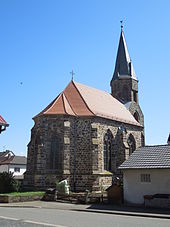Cappel (Fritzlar)
|
Cappel
City of Fritzlar
Coordinates: 51 ° 7 ′ 38 ″ N , 9 ° 20 ′ 19 ″ E
|
|
|---|---|
| Height : | 195 m above sea level NHN |
| Area : | 4.35 km² |
| Residents : | 367 (2008) |
| Population density : | 84 inhabitants / km² |
| Incorporation : | December 31, 1971 |
| Postal code : | 34560 |
| Area code : | 05622, 05683 |
Cappel is a village in the Schwalm-Eder district in northern Hesse and a district of the cathedral city of Fritzlar . The place consists of an "upper" and a "lower village" and is one of the smallest districts of the city with around 370 inhabitants. Despite the increase in population, Cappel has been able to retain its original village, rural character in a new building area to this day.
Location and facility
The place is about 5 km east of the city center, between Obermöllrich and the Wabern district of Niedermöllrich on a hill north of the Fritzlarer Ederflur . The district of Cappel has a size of around 435 hectares.
Cappel is a so-called Angerdorf . The Vordergasse branches off from Niedermöllricher Strasse (main street), and after a few hundred meters it joins the first again. The Anger between the two streets was probably originally a village used meadow or a sovereign unused part of the village. Today the church stands here.
history
1120 the place is mentioned as "Villa Capella ultra Frideslar sita" in the oldest register of the monastery Helmarshausen ( Helmwardeshusen ) from the 12th century. The first traces of permanent human presence in the area, barrows in the nearby Oberste Holz , date back to the 2nd millennium BC. In the southern area of the village, ceramic parts from the early Middle Ages were found.
The village was under the rule of the Hessian counts from the families of Werner and Gisonen . In 1137, after the Gisonen died out, it came into the possession of the Ludowinger Landgraves of Thuringia and after the Thuringian-Hessian War of Succession (1247–1263) to the Landgraves of Hesse , who gave it to followers as fiefs . However, the St. Petri-Stift in Fritzlar has also received monetary interest from Cappel since at least 1209, and since at least 1371 it has also received tithes from Cappel. The Teutonic Order was also wealthy in Cappel. In the 14th century village and court Cappel were Hessian fief of repetition of Meysenbug, from the time in Züschen -based and from 1443 in Riede resident dynasty of Meysenbug . In 1377 the village came to Hermann von Spiegel by inheritance . He pledged the village and part of the neighboring village of Niedervorschütz seven years later for 100 silver marks to Reinhard and Hans von Falkenberg . In 1428, Landgrave Ludwig I of Hesse again enfeoffed the Meysenbugs with the place, who held it until 1787 and also had patronage over the church and the lower jurisdiction . With the introduction of the Reformation in Hesse, Cappel was incorporated into the neighboring Obermöllrich.
The oldest still existing house in the village dates from 1680. The new church in neo-Gothic style was built in 1894 and replaced a half-timbered building from 1669; the eight-sided baptismal font and the two bells were taken over into the new building. The first underground water pipe came in 1911, the sewer system in 1953/54; this was connected to the Fritzlar sewage treatment plant in 1990. The first road was paved in 1955 . The village community center was built in 2004/05.
On December 31, 1971, the previously independent municipality of Cappel was incorporated into the city of Fritzlar.
population
The village's population was counted for the first time in 1575. At that time, Cappel had 16 households. The same number is given for the year 1747, when a tax cadastre was drawn up in Cappel. In 1812 there were 128 inhabitants. For 1835 22 houses, 160 Protestant, one Catholic and two Jewish residents are given. By 1885, the number of residents rose to around 170, and by 1925 Cappel passed the 200-inhabitant mark. After the Second World War , the population rose sharply, in particular due to the influx of people displaced from their homes, and reached a temporary high of 324. Then began a continuous decline until the place had only 237 inhabitants in 1961. Since then, this number has increased again, mainly due to the development of new building land.
In 1861 nine residents of Jewish faith lived in Cappel, in 1905 there were eight. The fate of the two Jewish citizens who lived in Cappel in the early years of the National Socialist era is unknown.
politics
The current mayor is Jörg Gertenbach. (As of October 2013)
Recreation
North of the village, a few minutes' walk away, is the Oberstes Holz forest area belonging to the Cappel district with well-developed paths that offer many opportunities for nature lovers, walkers, hikers, joggers and Nordic walkers. The terrain is mostly flat and popular with long-distance runners as an ideal training route.
literature
- Werner Ide, From Adorf to Zwesten. Local history pocket book for the Fritzlar-Homberg district. A. Bernecker Verlag, Melsungen, 1972
Individual evidence
- ↑ "Cappel, Schwalm-Eder District". Historical local dictionary for Hessen. (As of May 21, 2014). In: Landesgeschichtliches Informationssystem Hessen (LAGIS).
- ^ Federal Statistical Office (ed.): Historical municipality directory for the Federal Republic of Germany. Name, border and key number changes in municipalities, counties and administrative districts from May 27, 1970 to December 31, 1982 . W. Kohlhammer GmbH, Stuttgart and Mainz 1983, ISBN 3-17-003263-1 , p. 392 .
Web links
- Cappel on the website of the city of Fritzlar
- "Cappel, Schwalm-Eder district". Historical local dictionary for Hessen. In: Landesgeschichtliches Informationssystem Hessen (LAGIS).
- Literature on Cappel in the Hessian Bibliography

